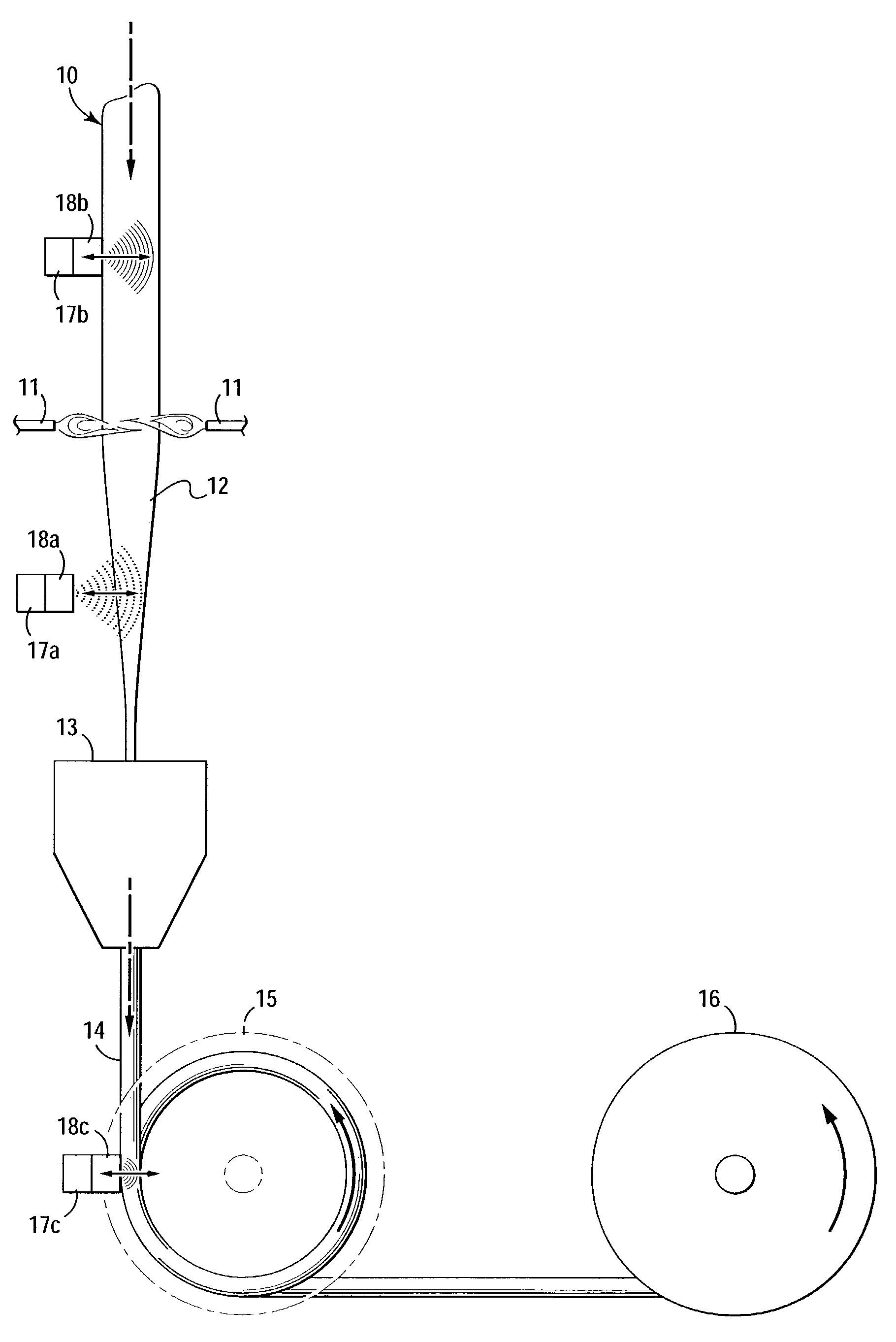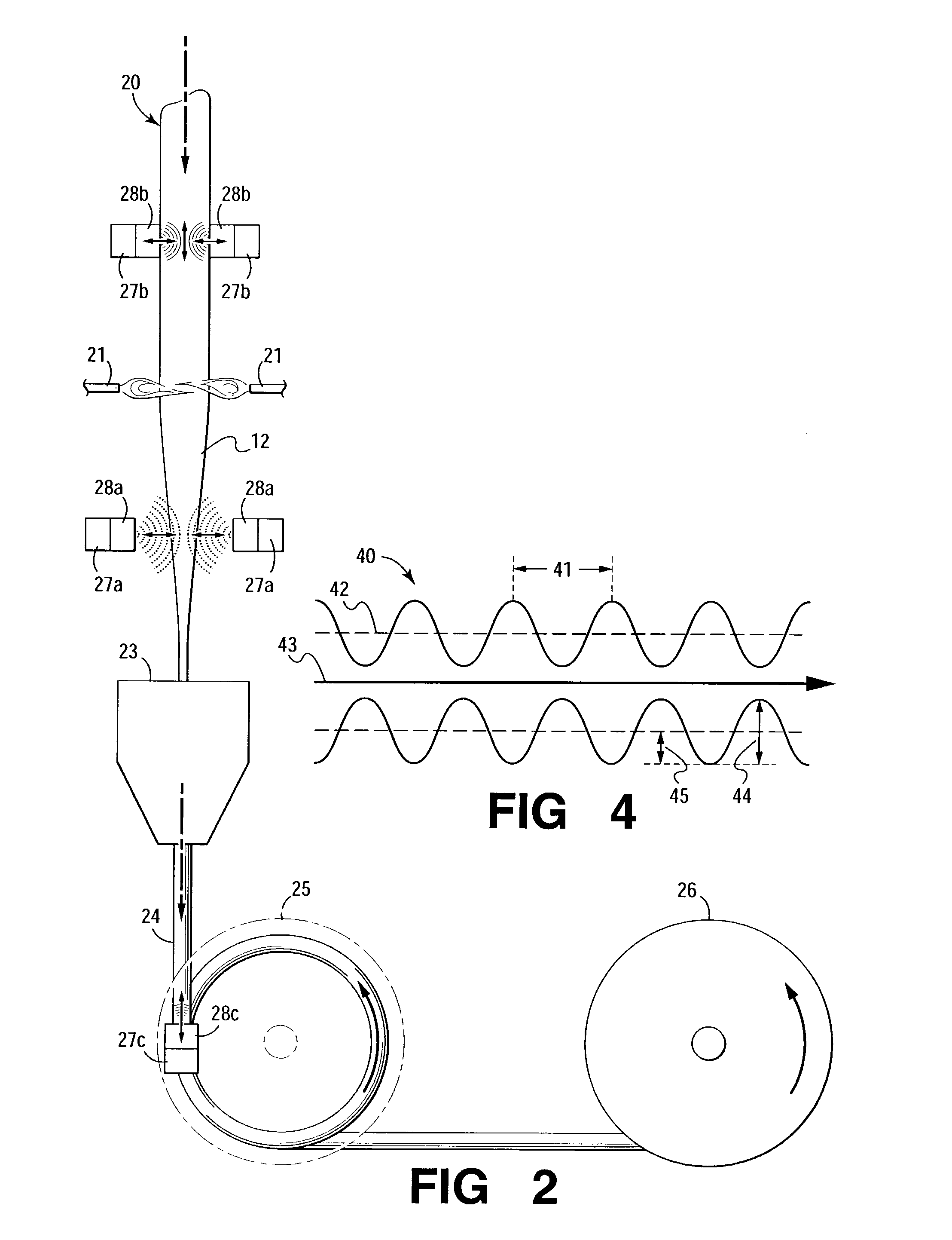Optical fiber fabrication and product
a technology of optical fiber and manufacturing tools, applied in the field of lightguides, can solve the problems of multimode fiber, optical fiber structure expected to dramatically change communication, and extensive effort directed to limiting pulse broadening, and achieves little or no change in cross-section size or index profil
- Summary
- Abstract
- Description
- Claims
- Application Information
AI Technical Summary
Benefits of technology
Problems solved by technology
Method used
Image
Examples
example 1
Fabrication of a Perturbed Multimode Fiber
[0077]Multimode fiber, having a 50 μm core of uninterrupted near-2 alpha profile, of matched cladding of undoped silica, containing a continuous axis-perturbation primary perturbation stream of 1000 μm period, is fabricated using the apparatus / method of FIG. 1. Oscillator-transducer 17a / 18a, operating at frequency of 10,000 Hz, with pressure of 2.4 Pascals (Pa) at the fluid surface, produces an acoustic wave of approximately 1 μm amplitude, in the fluid 12 in the vicinity of the fluid-solid draw interface, resulting in a surface undulation of >0.001 μm in the solidified fiber.
example 2
Fabrication of Enhanced Multimode Fiber of Co-pending Patent Application, “Enhanced Multimode Fiber,”
[0078]The procedure of Example 1 is followed, with drawing from a preform with index discontinuity consisting of an annular feature of reduced index of 50% Δ, with inner bound located at 0.7 of the core radius. An additional perturbation stream, of 1300 μm period, is superimposed on the primary stream for stripping the highest order mode group, by introduction of a second acoustic wave. Oscillator-transducer 17a / 18a, operating at dual frequencies—7500 Hz as well as 10000 Hz—with locally attained pressure of 1.5 Pa produces a composite acoustic wave—the composite of two 1 μm waves—as measured in the vicinity of the fluid-solid draw interface, with resulting superimposed surface undulations >0.001 μm in the solidified fiber.
example 3
Fabrication of Enhanced Single-Mode Fiber of Co-pending Patent Application “Optical Fiber For Single-Mode Operation,”
[0079]ESMF, for single-mode operation at 1550 nanometers (nm), containing a continuous size-perturbation stream of 700 μm period, is fabricated by use of the apparatus / process of FIG. 2. As described in the co-pending application, provision for single-mode operation over the operating range of 1300-1700 nm requires eliminating many unwanted higher order modes. As there discussed, single-mode operation over that wavelength range is effected by resonantly coupling all such higher order modes to cladding modes. To achieve this over the entire range of 1300-1700 nm requires coupling frequencies over the range of 350-700 μm. Acoustic waves of frequencies spanning the range 17000-34000 Hz are required to achieve such mode stripping. An oscillator-transducer 27a / 28a, operating with all frequencies from 17000-34000 Hz, with pressure of 10-20 Pa as measured at the surface of t...
PUM
| Property | Measurement | Unit |
|---|---|---|
| Length | aaaaa | aaaaa |
| Size | aaaaa | aaaaa |
| Frequency | aaaaa | aaaaa |
Abstract
Description
Claims
Application Information
 Login to View More
Login to View More - R&D
- Intellectual Property
- Life Sciences
- Materials
- Tech Scout
- Unparalleled Data Quality
- Higher Quality Content
- 60% Fewer Hallucinations
Browse by: Latest US Patents, China's latest patents, Technical Efficacy Thesaurus, Application Domain, Technology Topic, Popular Technical Reports.
© 2025 PatSnap. All rights reserved.Legal|Privacy policy|Modern Slavery Act Transparency Statement|Sitemap|About US| Contact US: help@patsnap.com



